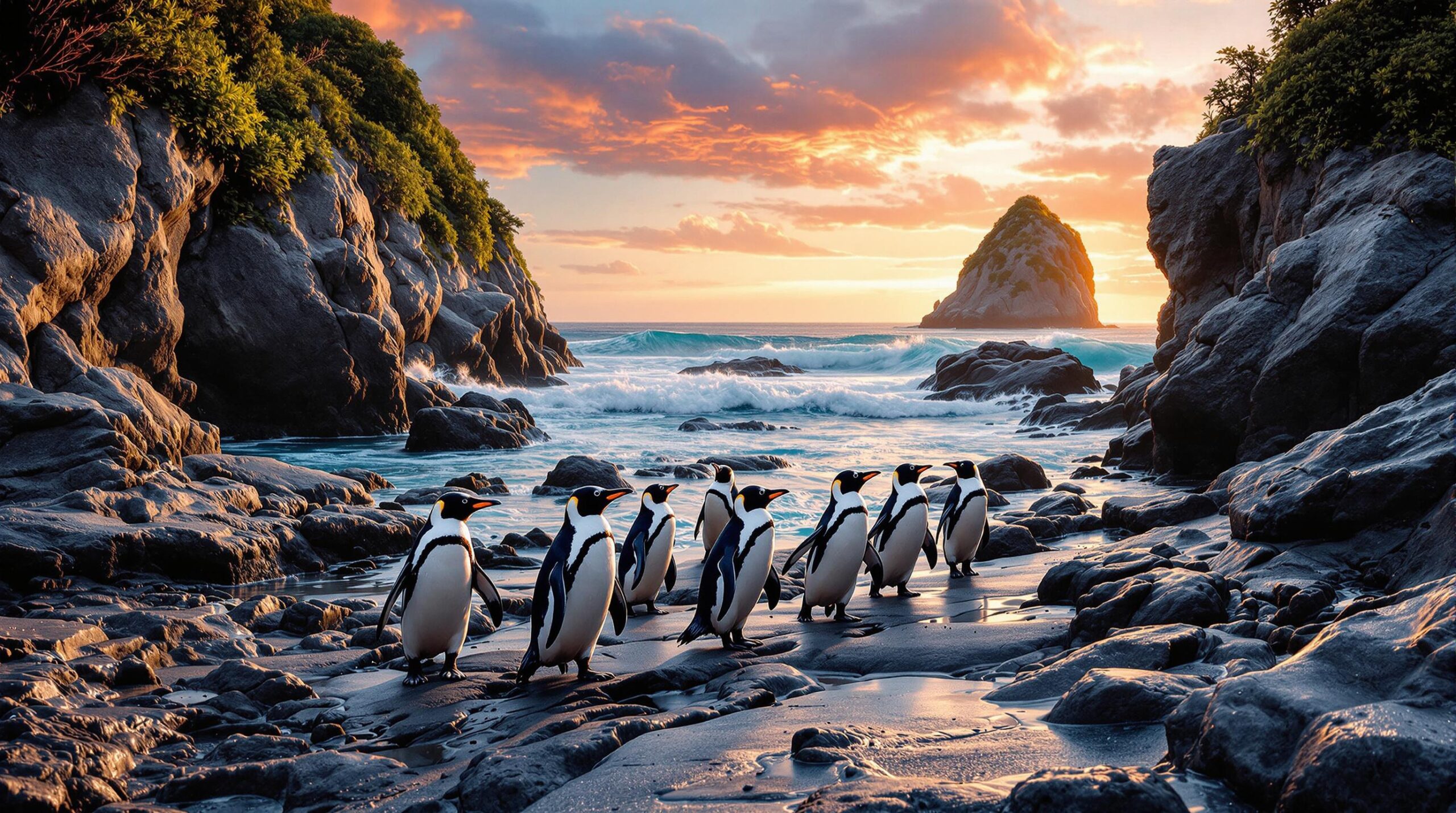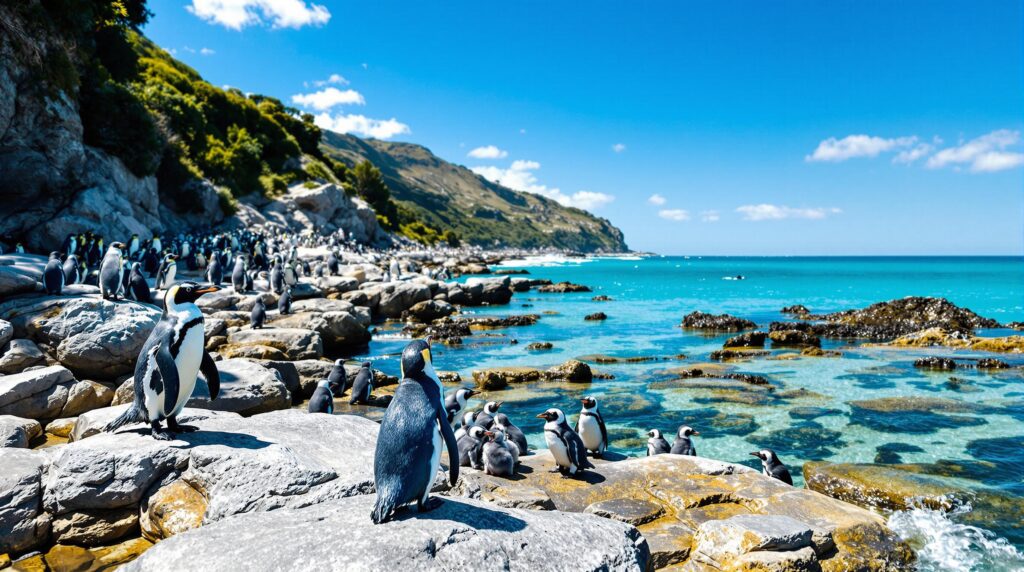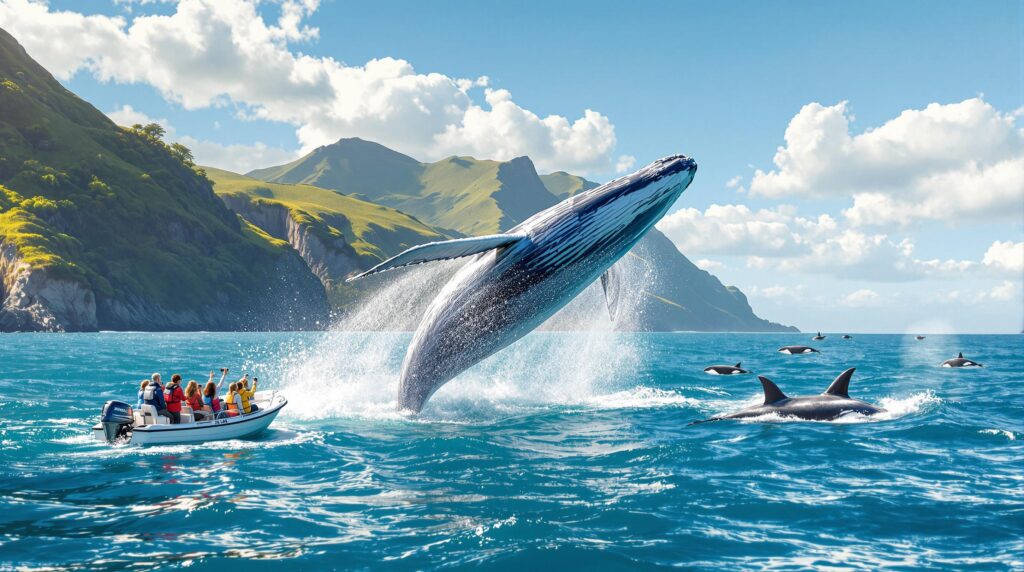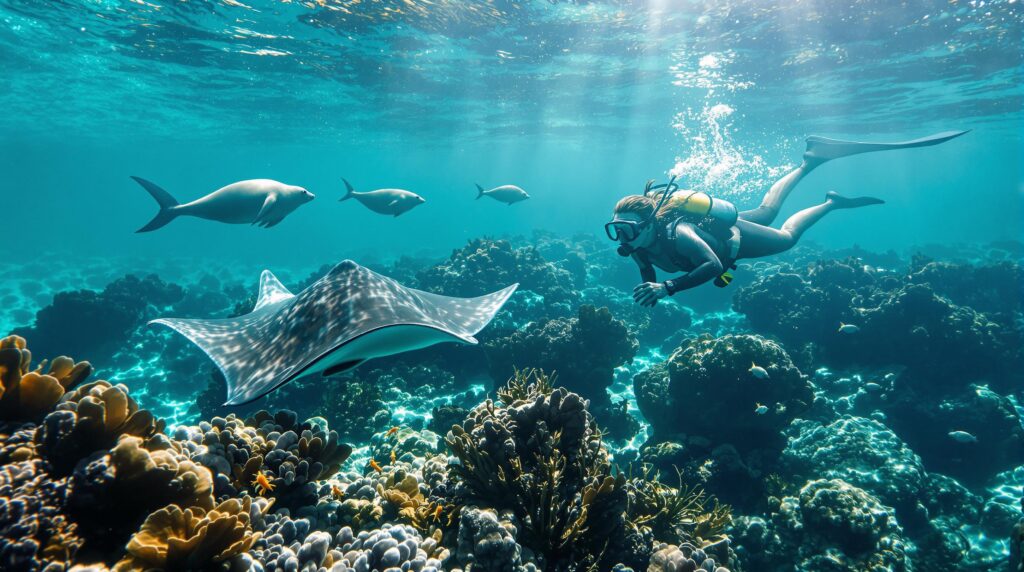Hello friends, I warmly welcome you on a journey through the captivating world of New Zealand’s penguins. My heart has been stolen by these enchanting creatures and the wild surroundings that nurture them. I have spent unforgettable hours watching the adorable blue penguins and the mysterious yellow-eyed variety. Their daily routines, charming waddles, and unpredictable antics evoke a pure sense of wonder and delight. Every detail, from the gentle lapping of the ocean waves to the soft hum of the Pacific breeze, has a story to tell. Today, I share with you my personal tales and local insights, spicing them up with practical travel tips, intriguing facts, and genuine awe. This narrative is punctuated with lively images, inspiring video moments, interactive tweets, and handy links that lead you deeper into the rich tapestry of New Zealand wildlife.
The enchanting encounter with these penguins is more than a wildlife watch – it is a deep dive into the soul of New Zealand. I invite you to explore the scenic habitats, intimate nesting sites, and behind-the-scenes conservation stories of these remarkable creatures. With every step, you will uncover a world of unforgettable experiences, secret spots, and heartwarming moments. Let’s set forth on this immersive adventure on foot and by sea, with a sense of curiosity and respect for these wonderful inhabitants of the wild.
Exploring the wild world of new zealand penguins
Wandering along the rocky coastal edges of New Zealand has gifted me with countless memories, and the penguins are at the center of many of them. I still recall the moment I first laid eyes on the tiny charmers at the Oamaru Blue Penguin Colony. Their distinctive little footprints, set against the dazzling backdrop of the Tasman Sea, evoked feelings of nostalgia and wonder. Every nuance of their behavior – from the unhurried, graceful waddle to the vigilant lookout for predators – offers a lesson in resilience and simplicity.
At this cherished Penguin Place nestled near the scenic coastal town, community efforts and scientific dedication shine through. I met dedicated researchers who spent their days ensuring the well-being of these diminutive creatures. One story that particularly moved me was about a creative solution to help the blue penguins cross busy roads safely: constructing a specialized 80-foot tunnel under a busy thoroughfare. This ingenious idea, born out of necessity and love for the creatures, reflects the combined efforts of local volunteers and the scientific community. It was a proud moment to witness the fusion of passion and practicality.

I was further introduced to local experts affiliated with Blue Penguin Tours, who organized guided Penguin Observation Tours full of fascinating insights about these unique species. They shared heartwarming anecdotes, such as how some penguins have become so accustomed to human presence that they now greet visitors daily. Their stories of daily returns from the sea, with a slightly whimsical march through shadowed tunnels, left a lasting impression on me. Sharing these genuine moments, I felt the spirit of New Zealand’s rich wildlife seep into every fiber of my being.
The charming colony vibrated with life each evening: hundreds of penguins making their way back to their cozy nests under the sparkling night sky. While observing this magical procession, I couldn’t help but feel deep admiration for the local conservation efforts. Organizations like the Yellow-Eyed Penguin Trust and initiatives under New Zealand Penguin Conservation have created sanctuaries where our little friends are shielded from dangers. I also enjoyed learning about the activities of Eco-Penguin Adventures and Kiwi Penguin Tours, which promote responsible and engaging wildlife experiences.
One of the more memorable experiences was accompanying a group of international visitors as we gathered for the nightly spectacle. We marveled at the sight of the tiny penguins emerging from the ocean, their silhouettes set against a magnificent palette of pink and purple skies, framed by distant seas. The experience felt almost ceremonial – a true celebration of the Wildlife of New Zealand that makes it so unique. Curious tourists repeatedly asked about the history behind the innovative tunnel solution, and I happily shared the story while also pointing them to resources like penguin identity stories and blue penguin anecdotes.
Personal journey into penguin encounter
The path leading to an intimate Penguin Encounter felt both serendipitous and deeply personal. During one twilight stroll near the colony, I encountered a family of blue penguins emerging with soft, cautious steps from their ocean retreat. The experience was illuminated by a gentle glow, as if nature itself was playing a soft lullaby. The birds’ subtle calls and delicate movements resonated with an inner rhythm that I had seldom experienced before. Listeners around me, tourists and locals alike, shared smiles and glances that transcended language – a mutual admiration for nature’s small wonders.
In that magical moment, my mind wandered back to the community that passionately protects these creatures. At the colony, a local scientist explained how clever adaptations – like sensory lighting and controlled pathways – play a crucial role in safeguarding the penguins from hazards such as vehicular traffic and even curious hedgehogs. Witnessing this intersection of science and nature reinforced my belief that every tiny creature holds a piece of the world’s intricate puzzle.
Every passing evening at the colony reaffirms what I have come to cherish: the deep connection between human care and animal resilience. I recall a particularly delightful instance when a penguin, seemingly aware of its role in this nightly ritual, paused as if to salute us before proceeding on its journey. The quiet marvel of that instant filled me with an ineffable joy often reserved for rare encounters with nature’s true masterpieces.
The vibrant community of researchers and conservationists continuously shares their passion by offering tours that enrich the visitor’s experience. Joining these Penguin Observation Tours, I learned more about the challenges faced by these pint-sized wonders, as well as the innovative methods used to secure their future. Sharing these encounters on social media platforms, such as New Zealand Wildlife features, has inspired many to visit and learn firsthand.
Every detail of this adventure, from the naturally worn bamboo nesting boxes to the soft hum of the ocean, speaks to the harmony between human intervention and nature. The journey deepens as you discover that the story of New Zealand’s penguins is also a tribute to the collective heartbeat of dedicated locals who fight for their survival every day. This shared responsibility is the essence behind organizations such as New Zealand Penguin Conservation and Eco-Penguin Adventures, whose efforts continue to build a legacy of protection and wonder.
Diving deep into the life of blue penguins
Walking beside the coastline, I have been immersed in endless tales of the Oamaru Blue Penguin Colony and the delicate life of blue penguins. These tiny birds, arguably the world’s smallest penguin species, have an allure that is almost magical. With their sleek blue-grey plumage and contrasting white bellies, every feature tells a saga of evolution, survival, and communal living. During my tours with Blue Penguin Tours, I discovered that these fascinating creatures not only dazzle with their appearance but also with the underlying rhythm of their lives.
Behind every waddling step and every squawk lies a story of adaptation. Their small size, roughly equivalent to a domestic cat, belies the complexities of their survival. Predators like ferrets and wild dogs view them as vulnerable prey, yet ingenious conservation strategies have made their lives more secure. One such solution is the inventive tunnel that protects their nightly march. I was privileged to witness first-hand how researchers used subtle lighting and recorded penguin calls to gently guide these delightful birds to safety.
I spent hours conversing with experts who devoted their careers to these wonderful creatures. Their passion was palpable when recounting how local volunteers, researchers, and conservationists joined forces to protect these birds. The insights they offered were sprinkled with fascinating facts: from the evolutionary significance of their blue-grey hue to the social structures within large colonies. This collective effort is something I found truly inspiring, and I continue to share these narratives with anyone curious enough to ask.
The thrill of this living experience also lies in the sensory details. While examining the compact, almost Hobbit-like wooden nests and the quiet murmur of gentle waves, I found myself appreciating every small aspect of nature. The cool, salty air, combined with the visual spectacle of hundreds of penguins emerging at dusk, creates a setting that is both calming and exhilarating. Many travelers, curious about this unique combination of adventure and quiet reflection, have joined local tours, which showcase both the beauty and challenges of this delicate ecosystem.
The uniqueness of these blue penguins is captured vividly in an engaging table I encountered during one of these visits:
| 🐧 Feature | 🌟 Description |
|---|---|
| 🐧 Size | 🌟 Approximately 25 cm tall |
| 🐧 Habitat | 🌟 Coastal areas and rocky shores |
| 🐧 Social behavior | 🌟 Highly gregarious and communal |
| 🐧 Diet | 🌟 Small fish, crustaceans, and squid |
This table not only highlights the physical attributes of the blue penguins but also reflects the essence of their daily lives at the colony. It echoes the sentiments of local experts and enthusiastic visitors who share the same deep admiration for these creatures. Exploring the colony feels like stepping into a vibrant world where human care and nature’s resilience blend seamlessly. Every detail is a testament to fierce local commitment towards New Zealand Penguin Conservation and the unforgettable charm of the Wildlife of New Zealand.
Respect for these small yet vibrant beings extends beyond the local community. It is heartening to know that organizations across New Zealand, such as those offering Penguin Encounter and guided trails by Eco-Penguin Adventures, are continuously enhancing conservation strategies. Their efforts not only preserve a crucial part of our natural heritage but also inspire countless visitors to support these initiatives.
My personal experience on these tours left me with profound respect and gratitude toward the efforts invested in protecting these special birds. The vivid moments and endless anecdotes of survival combine into an ever-repeating cycle of inspiration that I simply cannot keep to myself. For additional details on how these passionate communities work together, you might enjoy reading more about dedicated research found at penguin rehabilitation centers and check the fascinating stories on penguin species insights.
The small wonders of oamaru blue penguin colony
Nothing quite prepares you for the moment when you stand before the bustling colony at dusk. With excitement in my heart, I watched as the tiny penguins made their way from the ocean to their snug nesting boxes. The atmosphere was rife with anticipation, as families and conservationists alike gathered to witness this nightly marvel. Each bird, though small in physical appearance, carried the weight of decades of evolutionary brilliance and communal effort. Their journey, both delicate and determined, leaves a lasting impression on every visitor.
Walking alongside these colonies and engaging with local caretakers, I learned of the intricate measures taken to ensure their safe passage. Detailed pathways, subtle lighting schemes, and even specially recorded penguin calls help ease the birds’ journey home. The passion embedded in such well-thought-out plans reveals a community deeply committed to the survival of its native wildlife.
In conversations during one of these visits, guides explained that nurturing these creatures is about more than survival—it is about preserving a legendary connection with nature. I was introduced to the heartfelt notion of a Penguin Encounter that transcends simple observation; it is, in essence, a communion with natural history. Approaches like these have led to the establishment of dedicated platforms such as Blue Penguin Tours which ensure that every visitor gets a genuine and educational experience.
The experience is further enriched by an array of storytelling techniques. A well-structured series of narratives and data charts conveys the unique life cycles, feeding habits, and protective measures surrounding these animals. One particular chart I saw displayed the variations in population across breeding seasons, using vibrant emojis to denote significant numbers:
| 🐧 Season | 🌟 Penguin Count |
|---|---|
| 🐧 Peak (Nov-Dec) | 🌟 300 – 350 |
| 🐧 Off Season | 🌟 100 – 150 |
| 🐧 Breeding (May-Sep) | 🌟 200 – 250 |
This visual aid, along with the warm narration of personal experiences, painted a vivid picture of the continuous cycle of challenge and triumph experienced by these penguins. The mixture of data, personal anecdotes, and local legends left me with a sense of responsibility to share these tales and encourage sustainable tourism practices. For more inspiring travel hints, consider checking out guides at South Island campervan tips which align perfectly with the themed tales of my journeys.
The secret lives of yellow-eyed penguins
Delving into the secret realm of the yellow-eyed penguins felt like uncovering a hidden treasure. These birds, known for their distinctive yellow eyes and unique markings, exude an air of mystery and regal solitude. Unlike their blue counterparts, the yellow-eyed penguins are more reclusive and prefer secluded nesting sites tucked away in dense coastal forests and shrublands. I found their quiet elegance immensely appealing, and their special conservation programs, supported by organizations such as the Yellow-Eyed Penguin Trust, reveal a commitment to preserving their fragile existence.
Every time I visited their remote habitats, I was struck by a profound silence that envelops these areas. The serene backdrop, blended with the soft murmur of the ocean waves and the rustling of native flora, created a setting of solitude and introspection. Witnessing these penguins in their natural, undisturbed settings provided me with an intimate understanding of their life cycles. Their solitary nature, paired with specialized foraging habits, creates a natural balance that I came to deeply respect.
Guided excursions with local Penguin Observation Tours allowed me to explore these secret locations. On one such trip, I encountered a family of yellow-eyed penguins emerging gradually from a concealed cove. Their movements were measured and cautious, as if they were ever-aware of hidden threats from the deep forest. My guide explained that these birds focus on larger fish like sprats and pilchards, contrasting with the more varied diet of the blue penguins. This specialized behavior underlines their unique role in the coastal ecosystem.
The enchanting contrast between the lively blue penguins and the more reserved yellow-eyed ones provided me with a broader perspective of New Zealand’s rich biodiversity. As I wandered through the lesser-known trails, I imagined the quiet strength and beauty of these creatures, thriving in the secrecy of their natural habitat. It was a humbling experience, one that reinforced the significance of preservation efforts led by groups dedicated to safeguarding these species.
To visually complement these insights, I noted a striking table crafted during one of these excursions:
| 🐧 Trait | 🌟 Yellow-Eyed Penguin Biology |
|---|---|
| 🐧 Height | 🌟 Up to 60 cm |
| 🐧 Distinctive Features | 🌟 Yellow eyes and a bright yellow band |
| 🐧 Nesting Behavior | 🌟 Solitary or in small groups |
| 🐧 Diet specialization | 🌟 Focuses on larger fish such as sprats and pilchards |
The well-documented traits in the table provided valuable context and a quick reference to the unique lifestyle of these birds. Detailed conversations with naturalists enriched my understanding of their ecology, highlighting the need for strict conservation measures – a mission pursued by both the Yellow-Eyed Penguin Trust and passionate local scientists.
The entire experience felt like stepping into a realm of mystery that few have the privilege to witness closely. I found that even the smallest details—a particular call, the shimmer of feathers in low light—carry deep significance. The delicate balance that governs their existence has become a cherished memory, urging me to advocate for lasting conservation efforts. For those keen on planning an adventure in this hidden world, I recommend exploring travel guides that link wildlife encounters with local lore, such as those available through Kaikoura whale watching trips.
Every moment spent among the yellow-eyed penguins stands as a reminder of nature’s quiet resilience. Their understated beauty, coupled with the compelling narrative of their lives, continues to inspire me to explore, safeguard, and celebrate these true icons of the Wildlife of New Zealand. Their secret lives, observed by dedicated enthusiasts like myself, remain integral to the story of our natural heritage.
Solitary adventures with yellow-eyed penguin trust
During my ventures to witness the yellow-eyed penguins, I often found that the journey itself was as moving as the destination. Trekking through coastal woodlands and along secluded beaches, every step was accompanied by the sound of nature’s rhythm—a gentle rustling of leaves, distant bird calls, and the soft pulse of the tide. The setting felt intimate and protected, much like the philosophy behind the Yellow-Eyed Penguin Trust. Every effort to maintain the delicate balance of these secluded habitats is a testament to the unwavering commitment of local experts and nature lovers alike.
My wandering led me to remote hideaways where I could truly appreciate the birds’ solitary charm. Observing from a respectful distance, I noticed how each penguin seemed to have carved out its personal space in the vast coastal expanse. Their careful and rare interactions, the almost whispered exchanges between mates, and the tender care with which they attended to their chicks deeply touched me. These moments sparked countless reflections on the importance of preserving such pristine environments for future generations.
The trust’s dedicated conservation projects included weekly patrolling and carefully planned management of public access, ensuring the safety and privacy of these creatures. I was amazed at the meticulous planning that goes into every endeavor—from habitat restoration to structured public awareness sessions. Their initiatives truly embody the spirit of Eco-Penguin Adventures and are instrumental in fostering sustainable tourism practices.
In our discussions over locally brewed coffee, community members and conservationists eagerly exchanged practical tips for visitors. Their advice ranged from the best times of day to approach penguin nesting sites to mindful behavior to avoid causing unnecessary disturbances. These friendly recommendations were reminiscent of local legends in hospitality, much like what you might find through trusted New Zealand travel portals. I left those conversations with renewed hope and a heartfelt commitment to advocacy and preservation.
To encapsulate the essence of planning your next adventure, I jotted down a handy checklist that many travelers find essential:
- 😊 Check the seasonal activity of the penguins
- 😊 Book a tour with experienced guides from Kiwi Penguin Tours
- 😊 Respect local guidelines and conservation rules
- 😊 Capture memories responsibly using eco-friendly methods
- 😊 Research local accommodations and transport options (
Hi, I’m Mark, a 38-year-old travel writer who traded his backpack for a peaceful life in New Zealand. After exploring dozens of countries, I’ve found my home among native bush, coastal walks, and the welcoming spirit of Kiwis. I now write about hidden gems, soulful places to stay, and local tips to help travelers experience the real New Zealand – slow, beautiful, and full of meaning.



